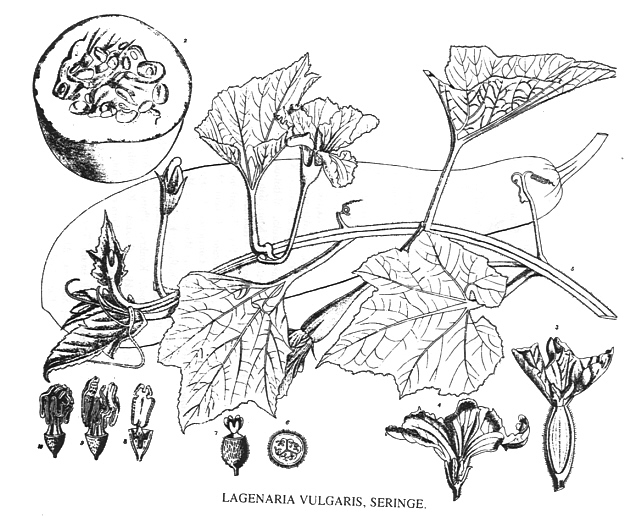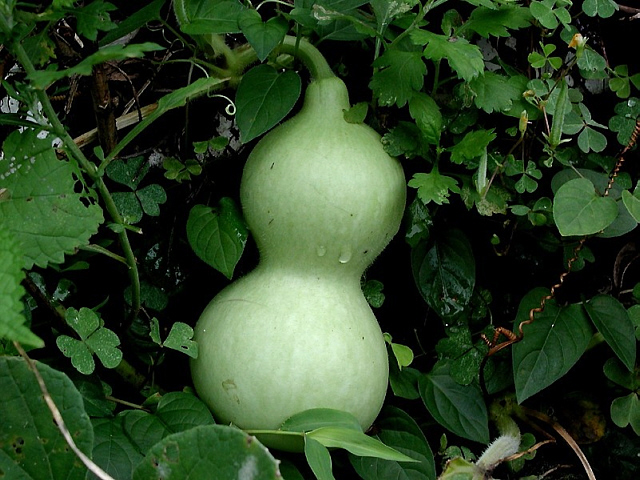

Zitierweise / cite as:
Carakasaṃhitā: Ausgewählte Texte aus der Carakasaṃhitā / übersetzt und erläutert von Alois Payer <1944 - >. -- Anhang A: Pflanzenbeschreibungen. -- Lagenaria siceraria (Molina) Standl. -- Fassung vom 2007-05-10. -- URL: http://www.payer.de/ayurveda/pflanzen/lagenaria_siceraria.htm
Erstmals publiziert: 2007-03-19
Überarbeitungen: 2007-05-10
Anlass: Lehrveranstaltung SS 2007
©opyright: Dieser Text steht der Allgemeinheit zur Verfügung. Eine Verwertung in Publikationen, die über übliche Zitate hinausgeht, bedarf der ausdrücklichen Genehmigung des Verfassers
Dieser Text ist Teil der Abteilung Sanskrit von Tüpfli's Global Village Library
WARNUNG: dies ist der Versuch einer
Übersetzung und Interpretation eines altindischen Textes. Es ist keine
medizinische Anleitung. Vor dem Gebrauch aller hier genannten Heilmittel wird
darum ausdrücklich gewarnt. Nur ein erfahrener, gut ausgebildeter ayurvedischer
Arzt kann Verschreibungen und Behandlungen machen!
Falls Sie die diakritischen Zeichen nicht dargestellt bekommen, installieren Sie eine Schrift mit Diakritika wie z.B. Tahoma.
Verwendete und zitierte Werke siehe: http://www.payer.de/ayurveda/caraka0001.htm

Abb.: Lagenaria siceraria (Molina) Standl.
[Bildquelle: Kirtikar-Basu, ©1918]

Abb.: Lagenaria siceraria Standl.
[Bildquelle: Wikipedia]
Drury:
"Lagenaria vulgaris (Ser.) N. O. Cucurbitaceae. White Pumpkin, Bottle-gourd, Eng. Hunea-kuddoo, Duk. Shora-Kai, Tam. Bella-schora, Mal. Lavoo, Beng. Anapa-kai, Tel.
Description.—Stem climbing softly pubescent; calyx campanulate; petals rising from within the margin of the calyx; tendrils 3-4 cleft; leaves cordate, nearly entire or lobed, lobes obtuse, or somewhat acute, glaucous; flowers fascicled, white; petals very patent; fruit pubescent, at length nearly glabrous and very smooth; seeds numerous, flesh-white, edible; fruit bottle-shaped, yellow when ripe. Fl. July—Sept.—W. & A. Prod. i. 341.—Cucurbita lagenaria, Linn. sp.—Roxb. Fl. Ind. iii. 718.—Rheede, viii. t. i. 4, 5.——Cultivated.
Medical Uses.—The pulp of the fruit is often used in poultices ; it is bitter and slightly purgative, and may be used as a substitute for colocynth. A decoction of the leaves mixed with sugar is given in jaundice.
Economic Uses.—The fruit is known as the bottle-gourd. The poorer classes eat it, boiled with vinegar, or fill the shells with rice and meat., thus making a kind of pudding of it. In Jamaica, and many other places within the tropics, the shells are used for holding water or palm-wine, and so serve as bottles. The hard shell, when dry, is used for faqueers' bottles, and a variety of it is employed in making the stringed instrument known as the Sitar, as well as buoys for swimming across rivers and transporting baggage. There is one kind, the fleshy part of which is poisonous.—Royle. Don."
[Quelle: Drury, Heber <1819 - 1872>: The useful plants of India : with notices of their chief value in commerce, medicine, and the arts. -- 2d ed. with additions and corrections. London : Allen, 1873. -- xvi, 512 p. ; 22 cm. -- s.v.]